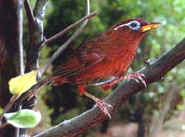Melodious Laughing Thrush,Hwamei
(Garrulax canorus)
Habitat: forests in mountain areas, bushes and bamboo woods near villages.
Feeding habits: get food from tree branches and bushes with its bill.
 Food: insects, berry and seeds of some vegetation. Food: insects, berry and seeds of some vegetation.
Size: with a full body length of 23 cm; weight: 50-75 g.
Habits:
Hwamei act alone or in pairs. Hwamei build their bowl-shaped nests with stems and leaves of vegetation from April to July each year and produce 3-5 eggs each time. Hwamei gets its name because there are white stripes around its eyes, which stretches towards behind the eyes like a white brows. Normally, the feathers of Hwamei are brown. In humid tropical areas, their feathers may become black. Black Hwamei is all black, but its brows are white. Male Hwamei is good at singing and its voice is very elegant and melodious. It is regarded as a distinguished and famous fancy bird. Hwamei has the habits to protect their action areas. Because of this, hunters often place tamed Hwamei in the action area of wild Hwamei to attract them and to let them fight, then catch them with nets. As a famous fancy bird in China, Hwamei cannot be hatched under man-made conditions yet. The Hwamei birds raised are all caught in wild. Large amount of Hwamei birds are caught in recent years and the number of Hwamei in wild state is greatly reduced.
Category: Ave, Passeriformes, Timaliidae.
Distribution: all around Yunnan. Middle and South China.
Protection level: not listed in the list of protection animals. But, in the bio-diversity schedule of China for the 21st century, it is listed as a preferred protection bird.
 
|